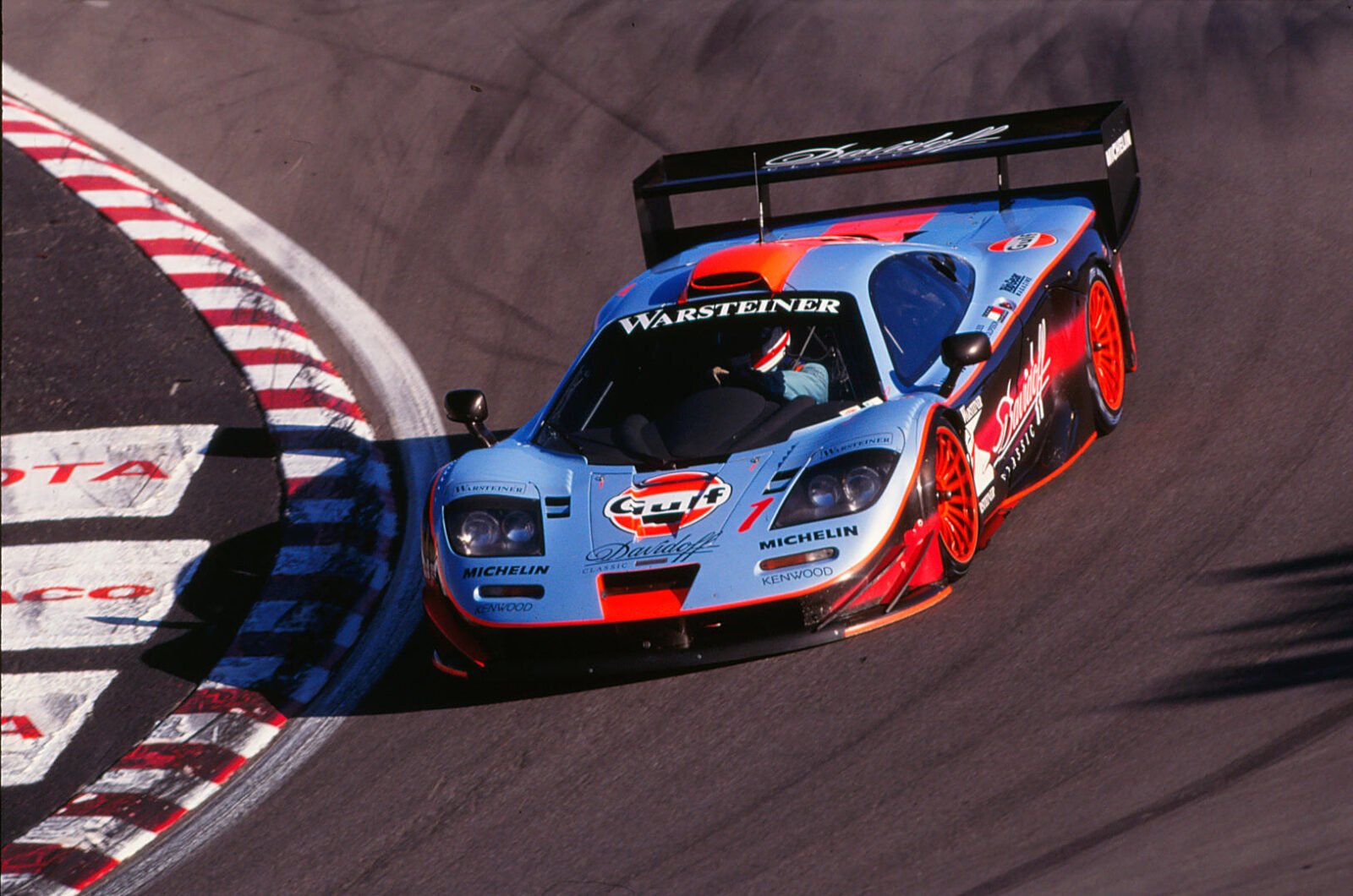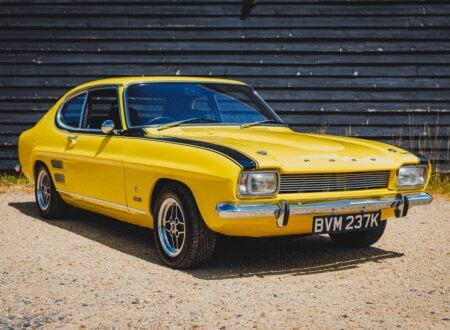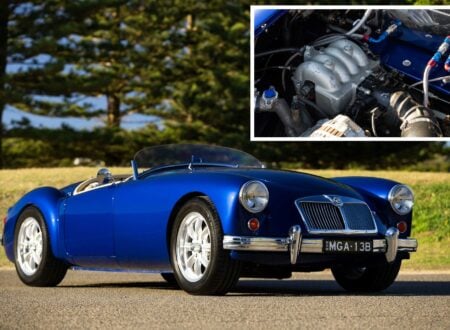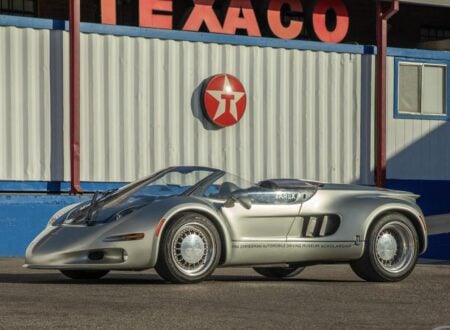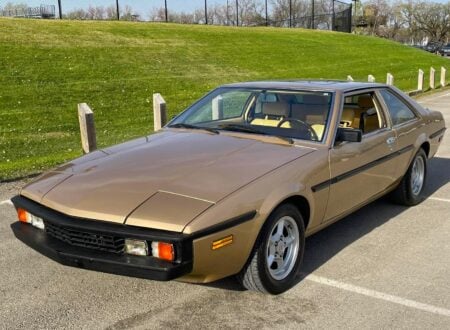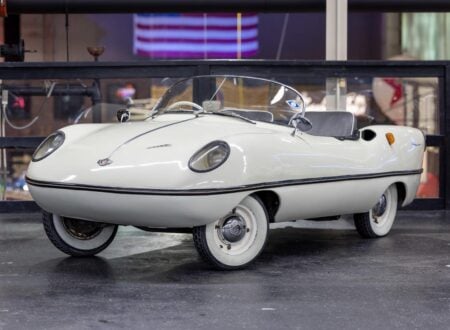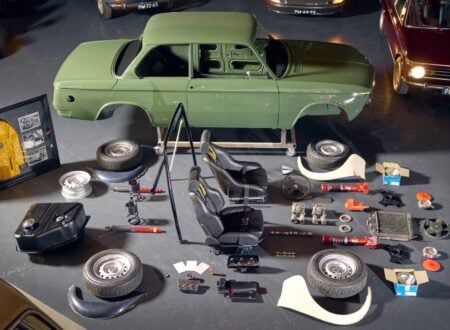The Gulf racing livery was propelled into motorsports stardom on the fame of the 1967 and 1968 Le Mans victories of the Gulf/JW Wyer Automotive team, followed by the release of the 1970-1971 movie “Le Mans” starring Steve McQueen which featured a Gulf liveried Porsche 917K.
This stardom made the Gulf livery iconic and its fame has continued through to the present day. Gulf’s livery has adorned cars from a variety of teams and companies, not least of which has been McLaren, who have teamed with Gulf to produce cars for customers who want to have their new car painted in the classic Gulf livery.
Fast Facts – Gulf Racing Livery History
- The Gulf motorsport livery that race fans are familiar with was created in 1967.
- The livery was first used on the Gulf Mirage-Ford M1 cars and then on the Ford GT40 cars that raced the 24 Hours Le Mans in 1968 and 1969.
- The car that became a legend wearing the Gulf livery was the Ford GT40 chassis number P1075 which won Le Mans in both 1968 and 1969, becoming at the time the third car to accomplish this.
- For the 1970 season Gulf’s team changed to specially modified Porsche 917K which for the Le Mans race featured a rear deck modeled on the Lola T70 Mk3/3B.
- That 1970 race saw the movie making team from Solar Productions taking film footage and fielding cars in the race as a part of their making the movie “Le Mans” starring Steve McQueen.
- The car that starred in the movie was a Gulf liveried Porsche 917K with Steve McQueen portrayed as its driver. This movie brought the Gulf livery into world prominence.
- Gulf has maintained a high profile in motor sports up to the present day and Gulf sponsored teams competed in selected Formula One events during 2023 wearing a classic Gulf livery.
The Origins
The beginning of the Gulf racing car livery that adorned many famous recipients of checkered flag victories began with the paint scheme that adorned Gulf’s aviation manager Major Alford J. Williams’ private aircraft, a Grumman G22 “Gulfhawk II”, which he took delivery of in 1936. The Gulfhawk II was painted in the company’s golden oil orange color scheme with a dark stripe feature, and it has been preserved through to the present day being on display at the National Air and Space Museum in Washington D.C.
Gulf were a company that pioneered the notion of “branding” their products and so it was a natural for them to become involved in sponsoring motor-sport teams, teams that promised to bring prestigious victories for the company to be associated with. They took their first tentative step with sponsorship for the “Mormon Meteor” speed record setting car that was campaigned by Ab Jenkins. This car was to morph through three versions, with the Mormon Meteor III being powered by a Curtis Conqueror 1,570 cu. in. (26 litre) 750hp aircraft engine.
This car was painted in an orange and dark blue livery, which was the corporate color scheme of sponsor Firestone Tires: but Orange was the Gulf color scheme also. This took place during 1936-1937, over the same time period of Major Alford J. Williams use of his “Gulfhawk II” aircraft and its 1938 tour of Europe.
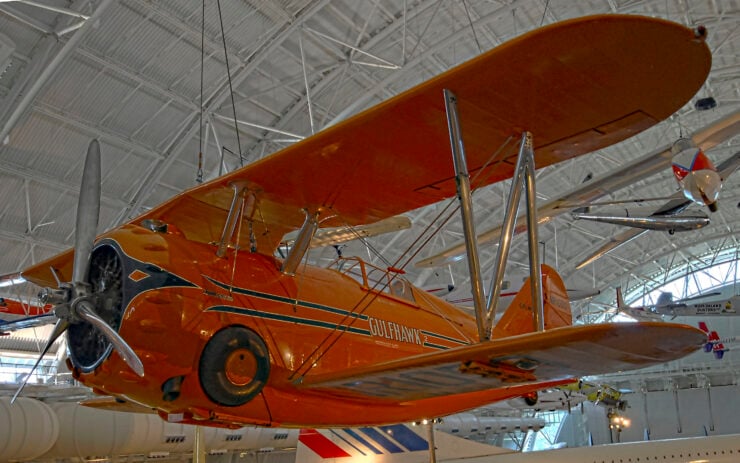

Gulf could see the promise of motor-sport to promote the Gulf brand and products and so got into a partnership with famous race car designer and builder Harry A. Miller. In 1937 Miller was working on a car fitted with a front DOHC four cylinder engine when Gulf purchased his project and commissioned him to build an Indianapolis car for them.
Gulf were keen to use racing cars to promote Gulf Oil products including their “No-Nox” 80 octane gasoline. The four cylinder cars did not live up to expectation and Millar moved to a radical mid-engine supercharged six-cylinder powered car with four speed gearbox and four-wheel-drive, this being painted in a dark blue livery. But again success in the prestigious Indianapolis 500 eluded Gulf.
It was not all wasted however: driver George Barringer took Millar’s cars to the famed Bonneville Salt Flats and there proceeded to break no less than fourteen International Class D (2.0 to 3.0 litres) records. This included a five kilometer speed of 158.446 mph, a one hour record of 150.242 mph, and five hundred miles at 142.770 mph. So Millar’s genius was vindicated despite the lack of an Indianapolis victory.
Its worth pausing to just think of the sheer courage, not to mention skill, of George Barringer. Speeds up around 140-160 mph in a car that is rather too similar to a soap box derby car for comfort, no seatbelt, no roll cage, no crash protection, just a big engine driving through skinny tires, and maintaining those speeds for a whole hour would be a test of courage, but doing it for five hundred miles? That must have taken extraordinary determined bravery.
So in terms of liveries Gulf had in this pre-war period sponsored the orange and blue Mormon Meteor III, and the dark blue Gulf-Millar special mid-engine all-wheel-drive speed record cars.
The Second World War that began in Europe in 1939 shifted Gulf’s focus and it would not be until well after the war was over and interest in motor-sport was established as foundation for big business that Gulf would again try dipping their toes into corporate sponsorship of motor-racing.
In 1966 the Vice-President of Gulf Oil Grady Davis was looking to try his hand in motor-sport and figured that the best vehicle with which to explore that would be a Ford GT40, a car that had proved its mettle at the 24 Hours Le Mans and which had in the process become near legendary. Grady Davis campaigned his GT40 in a dark blue livery with marigold orange center stripe and Gulf Oil logos, reminiscent of the livery of the Gulf-Millar speed record cars. He raced in the Daytona International Speedway and Sebring International Raceway events, in the process learning a great deal and making some good contacts. The most significant of those contacts would prove to be John Wyer of JW Automotive Engineering in Britain: John Wyer had previously been a team manager for Aston Martin and had been closely involved in the development of the Ford GT, and in late 1963 Ford had created Ford Advanced Vehicles with John Wyer in charge at a new workshop in Slough, near Heathrow Airport.
So Gulf Oil got into a partnership with a man who was one of the most qualified and experienced to undertake a top level motorsport campaign with the Ford GT40.
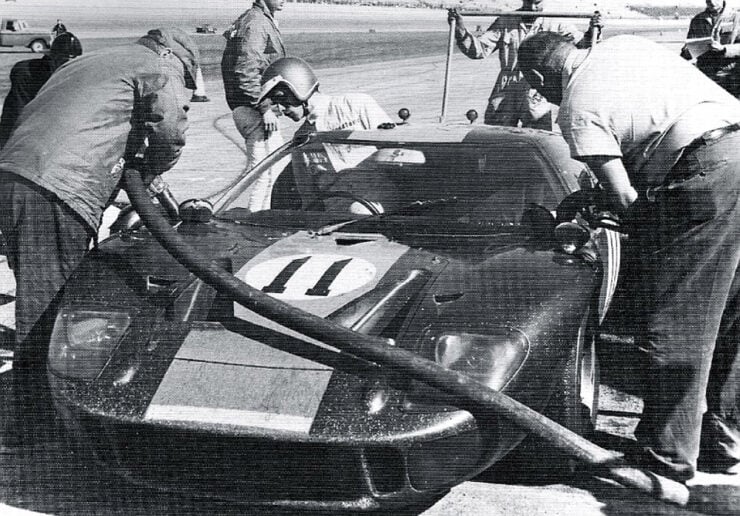

The ambitious project embarked upon by Gulf Oil and JW Automotive would be to campaign in the World Sportscar Championship series beginning in 1967. It would be this partnership that would give birth to the Gulf sponsorship livery that would be associated with the company through to the present day and the teams it sponsored for decades to come.
While the early Gulf colors had been orange or dark blue, or the Firestone orange with dark blue, Gulf’s branding came up with a new livery that was both reminiscent of the earlier color schemes, but new, and original. The new livery was a light powder blue with marigold orange center stripe and other details such as wheel color.
So it was a case of getting the paint colors just right and then into the spray booth, out with the spray gun, and Davis’ GT40 and the JW Automotive team cars all wore this quite unique and eye-catching livery. This would be the color scheme that would adorn Gulf Oil sponsored team cars from there on: and not only the cars themselves but helmets, clothing and ultimately branded products.
The first cars to wear this new livery and rack up racing successes were the Gulf Mirage-Ford M1 cars which had been developed by JW Automotive. With these the Gulf sponsored J.W. Automotive team began to carve out some victories beginning with the Spa 1000 km race using a Mirage-Ford M1 driven by Jackie Ickx and Richard Thompson. Ickx then took that Mirage-Ford M1 to victory in a sports car race in Karlskoga in Sweden. Following on from that Jo Bonnier and Paul Hawkins took their Gulf Oil liveried Mirage-Ford M1 to victory in a race in Skarpnack, Sweden. The final 1967 victory being taken by the team of Jacky Ickx and Brian Redman in the Kyalami Nine Hours race in South Africa.
By this stage the new Gulf Oil competition car livery was well established in the public eye.
A Gulf Oil sponsored and liveried JW Automotive Ford GT40 would win at Le Mans in 1968 with Pedro Rodríguez and Lucien Bianchi behind the wheel of the aging GT40 MkI chassis number P1075, and again in 1969 in the same car with Jacky Ickx and Jack Oliver behind the wheel. That Gulf Oil liveried Ford GT40 MkI became the third car to have won Le Mans two times in a row, and both car and its livery became legendary.
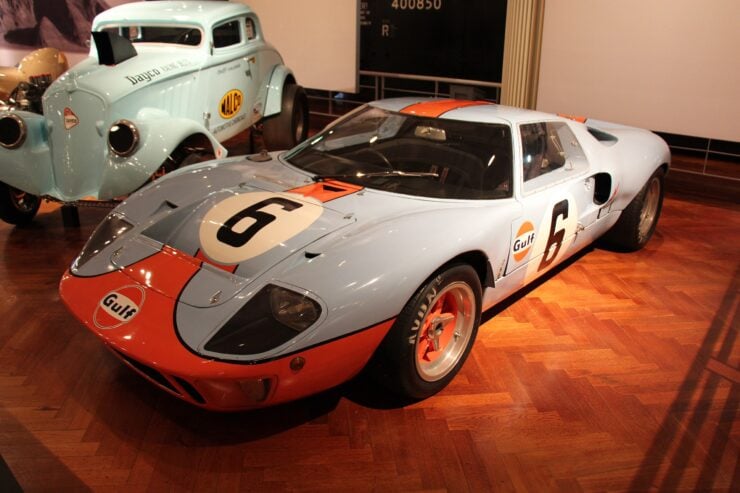

Even as the Gulf/JW Automotive Ford GT40 was providing a two year run of Le Mans wins John Wyer was well aware that a new car was needed for future success at Le Mans and his weapon of choice was expected to be the relatively new Porsche 917. Wyer asked Porsche for a three day set of trials and development work on the Österreichring in Austria and this was arranged.
The Porsche team arrived with technical people, workmen and equipment to create body panels on site, and a Can-Am 917PA Spyder as a test comparison car. The test drivers found that the Can-Am car was preferable to other versions and work was undertaken to create a new design rear end for the 917. The creative work was of course primitive yet practical and involved quantities of duct-tape and remodeled sheet aluminium: but the design was tested and established and back at the Porsche works the production version was created to Porsche’s typical high standards.
The car that emerged from this creativity was the Porsche 917K (Kurzheck – meaning “short”). John Wyer did not use this basic design for Le Mans however but instead his team used the design of the Lola T70 Mk3/3B to create a new rear deck. This was needed because Le Mans is a circuit that presents some quite unique challenges, one of the most critical being stability and aerodynamic efficiency at the very high speeds encountered on Mulsanne Straight and other parts of the circuit.
John Wyer racing did not gain a Le Mans victory with their three Porsche 917 cars in 1970, with one car breaking down and another crashing, but they achieved a creditable second place in 1971 with Richard Attwood and Herbert Müller driving. This car, wearing the race number 2 became one of the iconic cars to wear the Gulf livery.
The 1970 and 1971 Le Mans were to make the Gulf livery even more iconic than might have been possible just through race wins alone – even Le Mans race wins. The film team from Solar Productions was at the 1970 race to film sequences for the upcoming movie “Le Mans”. This movie was to star Steve McQueen, himself an accomplished racing driver, and race prepared cars to compete in the event.
McQueen had purchased a Porsche 908 Spyder to race. Prior to Le Mans McQueen had raced that 908 at the Sebring 12 Hour race with heir to the Revlon empire Peter Revson as his co-driver, and achieved a second place podium finish, only twenty seconds behind the race winner.
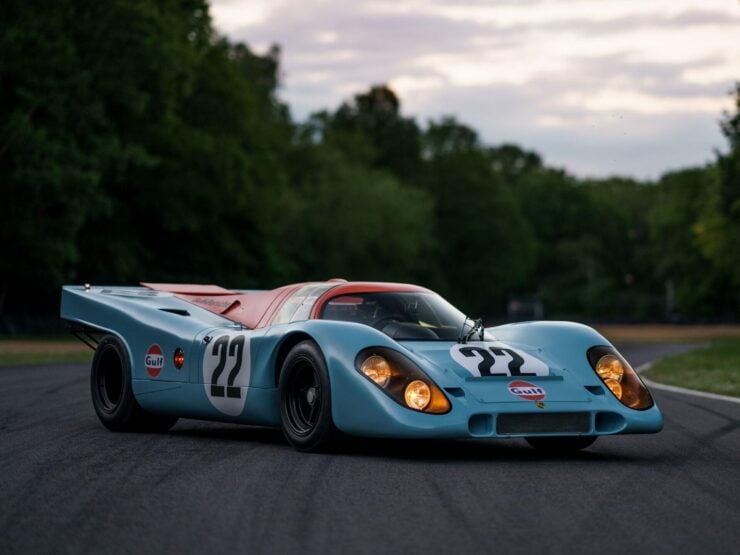

Steve McQueen was intended to race in Le Mans in a JW Automotive Porsche 917 in Gulf livery with Formula One World Champion Jackie Stewart as his team-mate, however because McQueen’s life insurance company would not insure him for the Le Mans race that arrangement was not able to happen.
Solar Productions had the Porsche 908 equipped as a camera car, and had six cameras strategically located around the track to get authentic race footage. After the race the company hired the circuit for three weeks for staged film sequences including crash sequences using re-bodied old Lola racing cars.
Motor racing is dangerous, as the signs often seen at race tracks remind us, and it was during that post-race filming that a serious accident occurred when a Porsche being driven by Formula One driver David Piper experienced a front tire blowout at high speed. Sadly his injuries were sufficiently serious that he had to have his lower-right leg amputated.
The results of the professional and artistic work that went into making the “Le Mans” movie resulted in a film with gritty authenticity and although it did not do as well as hoped at the box office it has maintained a solid following, and it served to propel the Gulf livery into a stratospheric level of fame: and given that a Gulf liveried JW Automotive Porsche 917K came second at Le Mans in 1971 the movie fame was reinforced with some real world racing fame.
Turning back to 1968, while the partnership with JW Automotive was working on endurance sports car racing, Gulf decided to expand their sponsorship involvement in motor sport and entered into an agreement with British car maker McLaren.
McLaren were determined to have their cars stand out in the company’s competition colors of orange with black contrast, and they wanted simply to have the Gulf logo displayed on their cars.
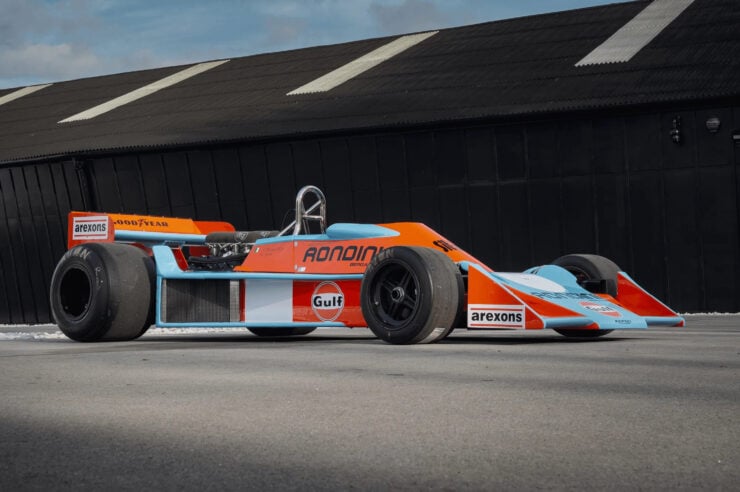

Gulf Oil’s sponsorship of McLaren covered some of the most prestigious motor-sport competitions extant. The team campaigned in Can-Am, Indycar and Formula One, and in addition to this Gulf sponsored the Brabham Formula One team also.
McLaren managed to compete with great success in the Can-Am series from 1968-1972 racking up thirty five victories and twenty first/second finishes.
1972 was to see new rules implemented for Le Mans and the Porsche 917 found itself banned from the race. Gulf deepened its commitment to motorsport with the formation of the Gulf Research Racing Company in partnership with JW Automotive in Britain.
The car of choice for this new venture was the Gulf Mirage GR6. This car was derived from the Mirage M6 and was built around a steel reinforced riveted aluminium chassis with fibreglass body. The car was powered by a 3 litre Ford Cosworth DFV (Double Four Valve) V8 which had been created to be a Formula One engine and which was detuned for the GR6 sports car.
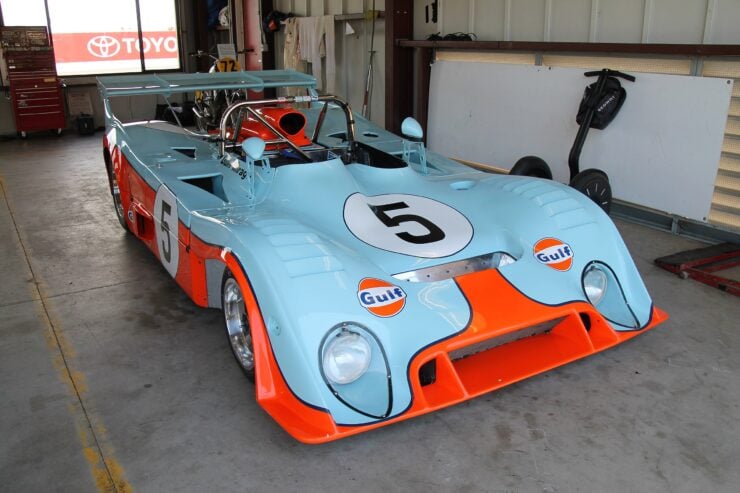

The new car design took time to develop to make it truly competitive as the cars were evolved through the 1974 GR7 and 1975 GR8 versions.
The GR7 saw Gulf obtain second place in the 1974 World Championship for Makes, an encouraging sign of the progress that was being made. Then in 1975 the GR8 proved its mettle with the team of Jacky Ickx and Derek Bell obtaining a win at Le Mans with team-mates Vern Schuppan and Jean-Pierre Jaussaud earning third place.
On that wave of success Gulf withdrew from endurance racing, and the Mirage project was purchased by American entrepreneur and race car driver Harley Cluxton III who bought the team and all associated manufacturing rights from John Wyer and the Gulf Research Racing Company. They would go on to second place podium finishes in 1976 and 1977.
Gulf also sponsored Italian privateer Alessandro Pesenti-Rossi for his 1976 Grand Prix campaign in a “007” numbered Tyrrell which was fully painted in the Gulf livery. At the time it was the only Grand Prix car to wear the full Gulf livery.
It would take a full two decades before Gulf would decide to resume its motor sport involvement, this time with the brief sponsorship of the Kremer Porsche Spyder K8.
The Kremer K8 was a creation of brothers Erwin and Manfred Kremer whose team was Kremer Racing.
Kremer Racing based their K8 on the Porsche 962 using a custom chassis created by John Thompson at TC Prototypes in Britain. The K8 was progressively evolved into an open cockpit, two-seater with a windscreen and a substantial roll-bar to comply with the car design rules.
Gulf had come on board with sponsorship to enter the car in the 1994 Le Mans with a driving team comprising five time Le Mans winner Derek Bell, Jürgen Lässig and British racing amateur Robin Donovan. Bell was hoping to match Jacky Ickx achievement of having six Le Mans victories under his belt. However, as things turned out he finished in sixth place. A good result, but no cigar. The 24 Hours Le Mans is a race that proves to be reliably unpredictable, and many hopes have been dashed on that wall of unpredictability.
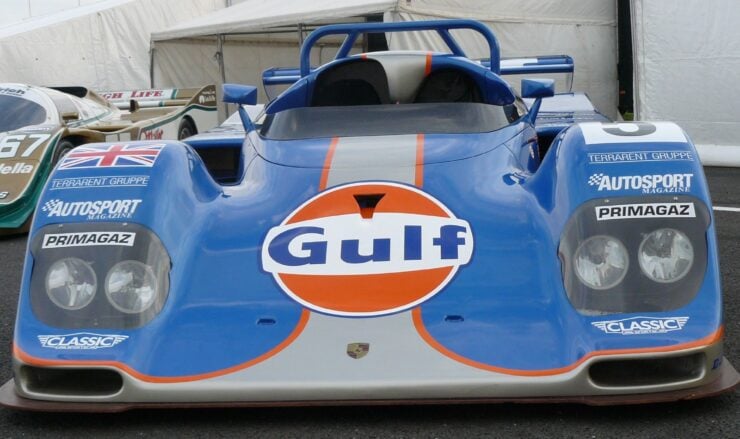

The livery for this car was distinctly different from the Gulf livery of the sixties and seventies. This car was painted in a deep royal blue with grey stripe from bonnet/hood to tail with a marigold orange outline, and grey along the sill line. It was a very new look and quite a departure from the livery that had become a hallmark of Gulf sponsored teams, yet it was a faithful throwback to the dark blue of the Mormon Meteor and the Harry A. Miller speed record car.
In 1995 Gulf decided to throw their hat into the ring with British car maker McLaren once again, this time with a view to having a McLaren F1 GTR as the competition weapon of choice.
The McLaren F1 was, and still is, one of the greatest road cars ever created, and it takes the old British idea of “safety fast” to a whole new dimension. The McLaren F1 GTR was the racing version of the car and in a real sense re-awakened the original spirit of the 24 Hour Le Mans, which was to race performance cars that could be used on the road. This proved to be a winning formula and the McLaren F1 cars from various teams took 1st, 3rd, 4th and 5th places, with the Gulf sponsored car taking 4th place.
The livery for the Gulf McLaren F1 GTR was a dark blue with red around the scuttle line and a red stripe from bonnet/hood to the rear deck, a grey separator stripe, and red wheels. Gulf’s company colors had changed a bit by this time and the livery for the racing cars coordinated with the new company colors.
For 1996 the Gulf McLaren team achieved a 5th and 9th place at Le Mans and won the Global GT Championship title.
1997 saw the Gulf Team Davidoff McLaren revert their livery to the one which had been associated with the team in the 1960-1970’s: powder blue with marigold orange. Thus decked out the team took 2nd place at Le Mans with a Class win, using a McLaren F1 GTR “Longtail” driven by Jean-Marc Gounon, Pierre-Henri Raphanel, and Anders Olofsson.
This “Longtail” variant of the F1 GTR had been made necessary by last minute alterations to the race rules that necessitated a re-design of the F1 GTR in order to both comply with the rules and remain competitive. So the car was re-evolved and went on to prove its mettle on the track.
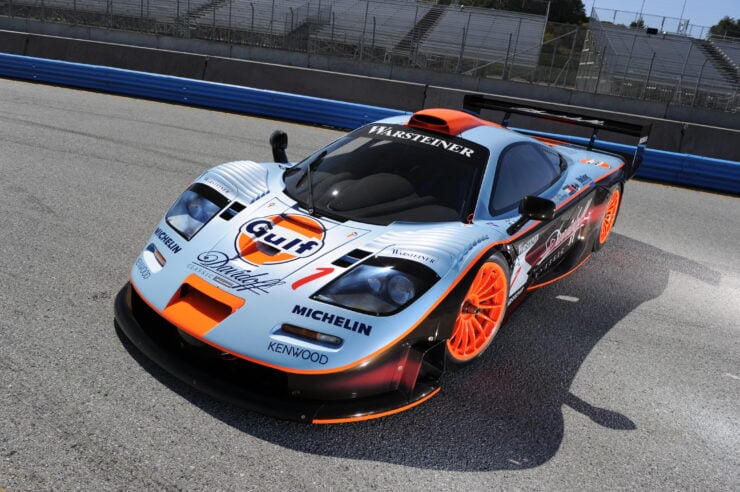

For 2001 Gulf teamed up with Stefan Johansson to campaign a race prepared Audi R8 which became both the Driver and Team Class Champions in the 2001 European Le Mans Series.
The Audi wore the traditional Gulf racing color scheme of powder blue with a marigold orange stripe extending from the bonnet/hood to the tail, with marigold orange sill line.
Then in 2005 Gulf partnered with Paul Belmondo Racing (PBR) who went on to win the LMP2 endurance racing category at both Monza and Silverstone circuits. The team obtained three podium finishes in the LMP2 competition which included a prestigious 2nd and 3rd place in the 2005 Le Mans, and in the final analysis place 3rd in the LMP2 Championship.
For the Paul Belmondo Racing campaign the livery of their Courage C65-Ford was mainly the Gulf powder blue but with a white stripe from bonnet/hood to rear deck.
Gulf continued their partnership with Paul Belmondo Racing by sponsoring his teams campaign in the Dakar Rally. The car was a Nissan X-trail 4×4 and the team performed well for the first half of the event but were forced to retire.
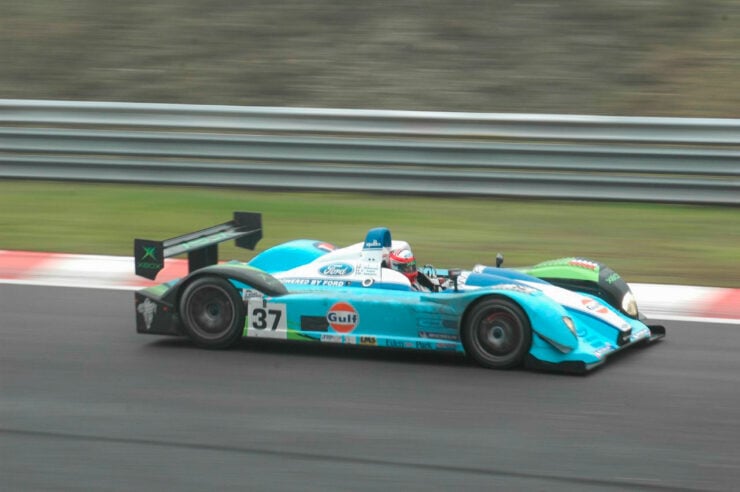

2007 saw Gulf sponsoring the Barazi-Epsilon team for their campaign in the Le Mans Series using the new Zytek 07S, which resulted in their obtaining third place in the LMP2 team standings for 2007. The livery for these cars was a rather pale powder blue with marigold orange center section extending from the front of the car to the rear deck.
During that year Gulf partnered with prestigious Swiss watchmaker TAG Heuer to create a series of Gulf motorsport themed watches. These have become a sought after item for collectors and motorsport enthusiasts.
2008 saw Gulf enter into partnership with Britain’s Aston Martin Racing, bringing to the Gulf brand not only motorsport competition prominence but also the association with the “James Bond 007” that became synonymous with Aston Martin when a specially secret agent tricked up DB5 starred in the movie “Goldfinger”. This partnership was to last through to 2016 and would see Aston Martin racing cars decked out in the classic Gulf racing livery. Indeed one of the Aston Martin DBR9 competition cars finished up wearing the “007” racing number.
The Aston Martin Racing team DBR9 cars gained victory in the GT1 category of the 2008 24 Hours Le Mans, and then in 2009 Gulf’s sponsorship was of the Aston Martin Racing LMP1 (Le Mans Prototype), with their DBR 1-2 racing car. This car was based on a a Lola B08/60 fitted with an Aston Martin DBR9 V12 engine and wore the race number “007”.
That first Aston Martin Racing LMP1 car was wrecked in a pre-race testing accident but another “007” was created and entered in the 2009 Le Mans along with another LMP1 car wearing the number “009”. That year marked the 50th Anniversary of Aston Martin’s last victory in the 24 Hours Le Mans with a car driven by Carroll Shelby and Roy Salvadori and no doubt hopes were for a repeat performance.
The DBR 1-2 cars proved to be highly successful obtaining an unbroken run of podium finishes that included a first, second and third at the Nurburgring and Le Mans Series titles for Teams, Manufacturers and Drivers.
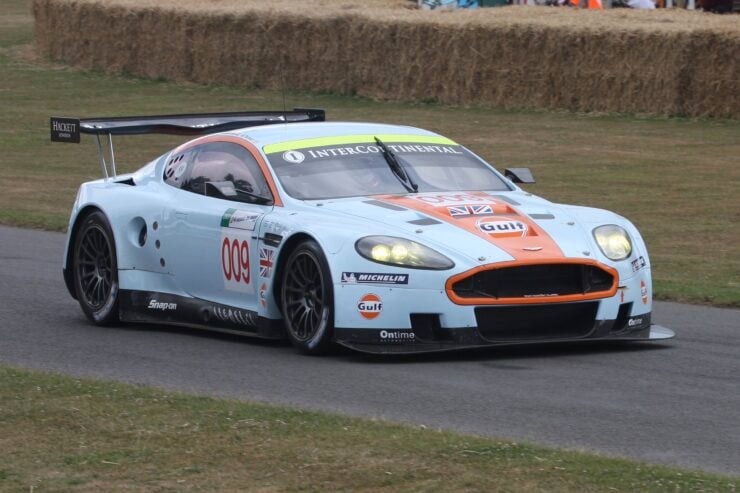

2010 saw the partnership of Gulf and Aston Martin Racing achieving success with a second in the 8 Hours of Le Castellet at France’s Paul Ricard circuit and another runner-up finish in the American Le Mans Series at Long Beach.
The following years would see the Gulf liveried Aston Martins competing in the Intercontinental Le Mans Cup, which was the precursor to the World Endurance Championship and between 2012-2016 they would manage a number of podium finishes.
In a first for Gulf they moved into the world of motorcycle racing with two sponsorship partnerships for the World Superbike Championship for 2017: those being Milwaukee Aprilia with a red and white livery with gulf logo, and Althea BMW in a black and white livery with Gulf logo. Also that year Gulf teamed up with Tockwith Motorsport (TMS) campaigning a Ligier LMP2 JS P217 at Le Mans and other World Endurance Championship and European Le Mans Series races for that season.
In 2018 Ford and Gulf teamed up together for the creation of a limited edition series re-creation of the Ford GT40. The new manufacture GT40’s were offered in the original livery of the twice Le Mans winning Ford GT40 chassis number 1075: believed to have been the only car to have won the 24 Hours Le Mans in two successive years running, making it a historic icon of the legendary race.


2018 was also the year that Gulf and Heritage Partner ROFGO entered a GPX race team Porsche 911 GT3R in the Spa 24 Hours race and managed a 1st place win.
ROFGO houses a collection of cars that have all worn the classic Gulf livery in motorsport competition and, far from being simply on static display, some of the cars in this collection are periodically used in racing.
2020 saw Gulf and Britain’s McLaren form a strategic partnership with the move to make Gulf liveried McLarens available and Gulf lubricants being the factory first preference used on all new cars.
The following year saw Gulf and McLaren field Gulf liveried McLaren MCL35M race cars in the Monaco Grand Prix with the Gulf livery emblazoned not only on the cars themselves but also on the race suits of the drivers. The team achieved a podium finish with Lando Norris and Daniel Ricciardo driving.
For 2022 the planned Gulf liveried McLaren cars became available. Customers could order their McLaren Artura or a McLaren Elva in the classic Gulf livery. Also on offer were the three Everrati Porsche 911 (964) electric vehicles.
You can find the current models available in Gulf livery here.
Gulf has entered the ethereal world of Formula One on a partnership with Williams and for the 2023 racing season Gulf asked fans to choose the Gulf livery to be used on the Williams Formula One cars that would compete in the Singapore Grand Prix. Three variants on the classic Gulf livery were offered, Visionary, Heritage, and Bolder than Bold. It was Bolder than Bold that was chosen, a livery that combines the Gulf tradition with some subtle new inspiration.
You can find wallpapers of the three liveries on the Gulf website here.
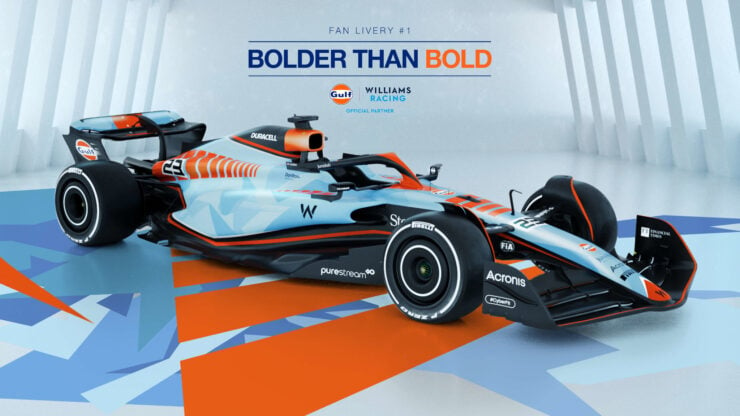

The Gulf livery, and the Gulf sponsorship associated with it, have been a vital part of top level motor sports through to the present day. Gulf liveried cars have taken some of the most prestigious honors that motor sports can offer: and the company continues to invest into teams all over the world. We hope they continue to do so and that the iconic Gulf classic livery will be seen at top level motor sport events for the foreseeable future.
Picture credits: Feature image at the head of this post courtesy Bonhams. All other pictures as individually credited including The ROFGO Collection.

